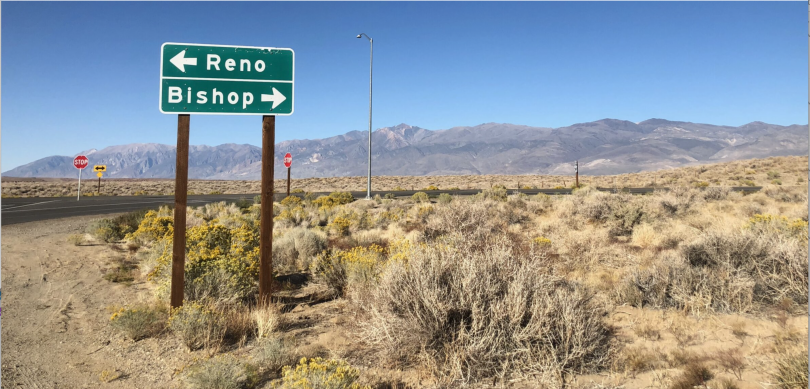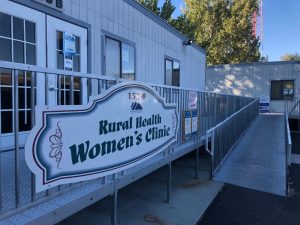by Lauren DeLaunay Miller, of the California Health Report
One day this spring, after an intense day at work, Megan packed an overnight bag and got in the car with her boyfriend.
She needed a medical procedure. But because the procedure was an abortion, she would need to drive for four hours to the nearest clinic with an appointment that month.
Megan, whose name has been changed to protect her medical privacy, lives in Bishop, one of California’s many rural areas where accessing reproductive care, particularly abortion services, can be difficult. For her, the closest abortion clinic with an appointment available within four weeks was in Pomona. Megan took two days off of work, and paid a few hundred dollars for the procedure and for a hotel where she stayed overnight.
She’s not alone. Even in California, where voters overwhelmingly decided to protect the right to reproductive freedom in the sate’s constitution this November, many rural residents struggle to access abortion services. These residents sometimes live hundreds of miles away from the nearest abortion clinic and lack the resources to trek to another part of the state. Meanwhile, they can encounter discrimination from health providers in their own communities, if they seek follow-up care for abortions, including medication abortions they may have had at home.
The lack of abortion access is especially difficult for people experiencing domestic violence, said Diane Gout, Director of Impact Strategies at the California Partnership to End Domestic Violence. Pregnant people in abusive relationships may need to conceal their abortion from their partner, who may also control their health insurance, finances and travel plans, so living far away from an abortion services provider is often impractical, she said.
Bishop is also home to the Bishop Paiute Tribe, the fifth largest tribe in California with over 1,500 members. Partially due to historical and current injustice, indigenous communities can also face high rates of domestic violence.
“A lot of folks who experience intimate partner violence and sexual assault experience coercive pregnancy or termination of pregnancy, and either direction is still violence,” said Vanessa Hays, executive director of Wild Iris, a family counseling and crisis center located in Bishop.
As Megan and her boyfriend wound through the Sierra Nevada mountains, she thought about all the women who might never be able to make this journey; who might end up forced into motherhood or risk their health as a result.
When Megan first learned she was pregnant, she assumed getting an abortion would be easy because she lives in California. But after calling every clinic she could find near her home in Bishop she was shocked.
“They said, ‘No, no, we don’t do that,’” Megan said. “That’s how I found out that you can’t get an abortion in Bishop or in the entire Eastern Sierra.”
In Dec. 2021, Gov. Gavin Newsom announced that California would be a “sanctuary” for abortion seekers. In the year since, California advocates and lawmakers have created a package of reproductive health care bills aimed at strengthening and protecting abortion access, especially for people living in states with abortion restrictions who may need to travel for California to get care.
In November, voters passed Proposition 1 which amends the state constitution to codify the reproductive freedoms “in their most intimate decisions,” including the right to abortion.
But despite these efforts to help people outside the state, abortion access remains limited for some of California’s own residents.
The Eastern Sierra, where Megan lives, is one of the most isolated parts of California, separated from the rest of the state by the towering peaks of the Sierra Nevada. Comprised of Inyo and Mono counties, this area is home to around 32,000 people. The nearest abortion clinics are over 200 miles away in Bakersfield, Lancaster and Palmdale, as well as Reno, Nevada.
Some pregnant people, like Megan, drive even further because they can’t get appointments at the closest clinics, or find the out-of-pocket costs too high. Megan first tried to book an appointment in Reno but was told she’d have to wait four weeks. She opted to drive to Pomona instead, 260 miles from Bishop.
It was a grueling journey, but she was glad she could do it. Within a few hours of the procedure, Megan, who is in her early 30s, was back in the car driving north, feeling elated and relieved. She felt like herself again.
“I’m educated, I could drive, I have money,” she said. “I have everything I needed and it was still hard.”
Inyo County isn’t the only county in California without abortion services. Forty percent of the state’s counties have no clinic of their own.
One of the biggest barriers to abortion access for rural residents is information on where and how to get one. The governor is trying to solve that problem. This May, Newsom introduced the Reproductive Health Package, a compilation of bills and funding totaling $125 million. One of the bills, Senate Bill 1142, directed $1 million toward a new abortion information website for the purpose of making sure all Californians have a source of accurate information about abortion services, including the location of the closest providers.
The website launched in September, but the information for the Eastern Sierra is misleading. For example, if you type in Bishop’s zip code, 93514, into the search tool, the site will tell you that the closest facilities are in Fresno, 89 miles away – which would be true if you drew a straight line on a map. For those traveling in vehicles, however, Fresno is around 220 miles away in the summer, when the road through Yosemite National Park is open. When that road closes, typically from November to May of each year, the drive to Fresno is close to 340 miles from Bishop, and there is no public transportation that will take you there. No information is given on the website for the most accessible clinics in Reno, Bakersfield, or Palmdale unless the user zooms out on the map manually to see more locations.
The search tool the state’s website uses is called Abortion Finder, created by the organization Power to Decide. A representative from Power to Decide said that the maps use straight lines in an effort to balance information with the privacy of the user, but they are aware, they say, of the limitations of this model and are actively working on solutions to help rural users get more accurate information.
The California website, abortion.ca.gov, is managed collaboratively by the Governor’s Office, the Department of Public Health, and the Government Operations Agency. Alex Stack, a spokesperson for Newsom’s Office, said he is aware of the issues with driving distance versus map distance and is continuously working on “improving the site to support those seeking reproductive health services.”
He pointed out that the map’s inclusion of telehealth options is particularly useful in rural areas.
Telehealth and at-home medication abortion options are sometimes the only option for people in abusive relationships or for low-income patients who are unable to travel or can’t afford to pay for a hotel.
But medication abortion is restricted to 10 weeks of gestational age, which is before many people know they are pregnant. While some pregnant people prefer the medication because it allows them to stay at home, others, like Megan, feel more comfortable with in-person medical care.
Jo is a Bishop resident who did opt for a medication abortion. But about a month after taking the pills, she was still bleeding heavily.
She started to get worried. Jo, who asked that her full name not be used to protect her privacy, said she went to the Rural Health Women’s Clinic in Bishop to get checked out. But she was afraid to tell the medical providers about the abortion. The clinic only provides abortions it deems medically necessary, and Jo worried she would be judged for choosing to get an abortion herself and for pursuing the medication route.
“I wanted so badly to trust that I could go in and get the care and tests I needed without being criminalized, shamed, profiled, or mistreated for having chosen to have an abortion,” said Jo, who identifies as a mixed-race person of color and has encountered structural racism when seeking health care.
“But I couldn’t trust it,” Jo said. “I kept thinking maybe if I was more white presenting I wouldn’t have to worry. Maybe if I had better insurance. Maybe if I dressed differently or made more money. Maybe if I get the “right” provider.”
Jo decided to tell the clinic she thought she was having a miscarriage. She didn’t tell them about the pills.
Clinics in conservative, rural areas like Bishop may opt out of providing abortions because of concern about backlash from the local community. Martha Kim has worked as an obstetrician-gynecologist in the Eastern Sierra for 11 years. She personally believes strongly in abortion access but said providing elective abortions at her women’s clinic wouldn’t be safe because it could lead to attacks on staff or patients. The clinic only provides them if deemed medically necessary.
“I’m not going to put my partners at the clinic on the line unless we get the backing of the community,” she said. “My most important thing is to keep my patients safe.”
Frustrated by the lack of help from official sources, Jo decided to take action herself. She now runs an Instagram account that links to information she’s independently compiled about local reproductive health resources. On the site, users can get information about insurance and financial resources for getting an abortion, learn where emergency contraception is available locally, find links to telehealth options, and read about the closest clinics.
“It set a fire under me,” she said of her abortion experience. “If the doctors can’t provide it, then at least we need to have a system and a network in place so that people can get the support they need to leave the area or be at home and safely get the care that they need.”
This article was first published by our friends at the California Health Report and is republished here under a Creative Commons license.
All photos by author Lauren DeLaunay Miller



Abortioneer.
Um, a LOT of things are not as available to folks living in rural areas as in urban areas. It goes well bey9nd abortions but I guess you are not interested in them.